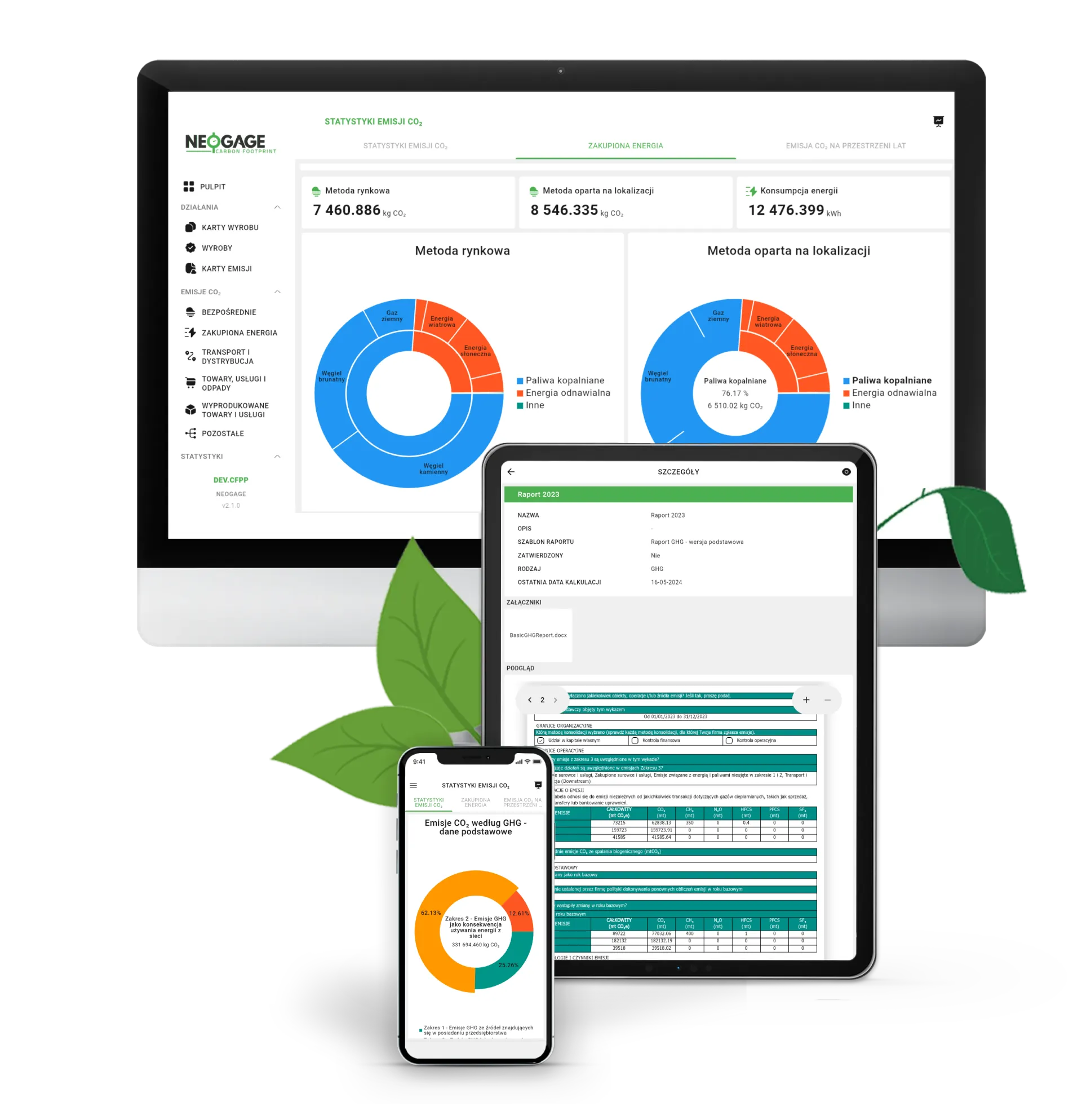How to Calculate a Company's Carbon Footprint Step by Step (Practical Guide 2025)
26 June, 2025
With growing ESG requirements and regulations such as CSRD, calculating the carbon footprint becomes not only an environmental responsibility but also a business requirement. In this guide, we explain step by step how to professionally and in accordance with international standards calculate an organization's carbon footprint.

Spis treści
What is an organizational carbon footprint?
An organizational carbon footprint is the sum of greenhouse gas emissions expressed in CO₂ equivalent (CO₂e) resulting from a company’s operational activities over a given period (usually a calendar year).
Standards and methodology
The most commonly used standard for calculating the carbon footprint is the Greenhouse Gas Protocol (GHG Protocol) – developed by WRI and WBCSD. It includes three emission scopes:
- Scope 1 – direct emissions (e.g., fuel combustion in company vehicles),
- Scope 2 – indirect emissions from electricity and heat,
- Scope 3 – other indirect emissions from the entire value chain (e.g., purchases, business travel, logistics, product use).
Emission scopes – detailed approach
The selection of scopes depends on the purpose of the calculation, reporting requirements, and the organization’s ESG maturity.
Note: Scope 3 often accounts for over 70% of an organization’s emissions – it should not be ignored!

How to calculate a company’s carbon footprint – step by step
Step 1: Define the purpose and boundaries of the calculation
- Will the carbon footprint be reported internally, for CSRD, or to clients’ CDP?
- Organizational boundaries: equity share, operational control, or financial control approach
- Operational boundaries: which plants, departments, projects will be included?
Step 2: Identify emission sources
- List all emission sources within Scope 1, 2, and 3.
- Example: vehicle fuel, electricity consumption, material purchases, transport, waste, travel, IT, external services.
Step 3: Collect activity data
- Gather quantitative data (e.g., liters of fuel, kWh, tons of material, km of transport).
- Data can come from invoices, ERP systems, meter readings, Excel sheets, internal surveys.
Step 4: Apply appropriate emission factors
- Assign an emission factor to each source (e.g., kg CO₂e / liter of diesel).
- Use reputable databases, e.g., DEFRA, ECOINVENT, EXIOBASE, IPCC, KOBiZE,
- NEOGAGE Carbon Footprint includes a ready-to-use database of factors.
Step 5: Calculate emissions
After collecting data and assigning appropriate emission factors, you can proceed with the actual calculations. For each emission category, multiply the amount of resource used by the emission factor (usually expressed in kg CO₂e per unit, e.g., kWh, liter, km, kg, etc.).
General formula:
Emissions (kg CO₂e) = Activity × Emission factor
Step 6: Data validation and analysis
Calculating the carbon footprint is just the beginning of making a real environmental impact and ensuring ESG compliance. Key steps at this stage:
- Emission structure analysis:
Identify areas generating the highest emissions. Is it energy, transport, production, purchases? This will help you set reduction priorities. - Year-on-year comparison:
Monitor the carbon footprint cyclically – preferably annually. This allows you to assess the effectiveness of reduction actions and set goals for subsequent periods. - Benchmarking:
Compare with other companies in the industry or capital group if you have access to comparative data. - Implementing reduction and offset strategies:
Based on the results, plan specific actions: e.g., switch to renewables, optimize logistics, supply chain changes, emission offsetting.
Step 7: Reporting and interpretation
- Prepare a report compliant with GHG Protocol / ESRS E1 / CDP.
- Identify the largest emission sources (hotspots) and potential reduction actions.
Emission Calculation Examples
Electricity
Consumption: 1,000 kWh per year
Emission factor: 0.8 kg CO₂e/kWh
Calculation:
1,000 kWh × 0.8 kg CO₂e/kWh = 800 kg CO₂e/year
Car Transport (Passenger Vehicle)
Annual mileage: 10,000 km
Average fuel consumption: 6 l / 100 km
Emission factor: 2.31 kg CO₂e/l
Calculation:
(10,000 km ÷ 100) × 6 l × 2.31 kg CO₂e/l = 1,386 kg CO₂e/year
Example Data for a Small/Medium IT Company
Assume a company with:
- 50 employees
- 300 m² office
- hybrid and on-site work
- One company car
- using cloud services and electronic equipment
Scope 1 – Direct Emissions
Related to fuel combustion in company vehicles, boilers, generators.
Company car (gasoline):
- Mileage: 10,000 km/year
- Consumption: 7 l/100 km → 700 l/year
- Emission factor: 2.31 kg CO₂e/l
- Emissions: 700 × 2.31 = 1,617 kg CO₂e / year
Scope 2 – Indirect Emissions (Electricity and Heat)
Purchased energy for the office (lighting, computers, servers, air conditioning, etc.)
Office electricity consumption:
- 300 m² × 150 kWh/m² = 45,000 kWh/year
- Emission factor for PL (2024): 0.616 kg CO₂e/kWh
- Emissions: 45,000 × 0.616 = 27,720 kg CO₂e / year
Scope 3 – Other Indirect Emissions
Employee commuting (on average 3 days/week to the office):
- 30 employees × 20 km per day × 3 days/week × 48 weeks = 86,400 km
- Gasoline car, emission: 0.175 kg CO₂e/km
- Emissions: 86,400 × 0.175 = 15,120 kg CO₂e / year
Remote work (20 people × 200 days):
- Laptop + monitor = 0.1 kWh/h × 8 h = 0.8 kWh/day/person
- Annual consumption: 200 × 0.8 × 20 = 3,200 kWh
- Emissions: 3,200 × 0.616 = 1,971 kg CO₂e / year
Paper purchase:
- 20 reams of A4 paper × 6 kg CO₂e = 120 kg CO₂e / year
Cloud services (e.g., Google Cloud / AWS – average):
- 5,000 kg CO₂e / year (estimated data based on provider reports)
Total Scope 3:
15,120 + 1,971 + 120 + 5,000 = 22,211 kg CO₂e / year
Summary of the Total Carbon Footprint of the IT Company:
Scope Emissions CO₂e/year
- Scope 1 - 1,617 kg
- Scope 2 - 27,720 kg
- Scope 3 - 22,211 kg
- Total - 51,548 kg CO₂e (about ~51.5 tons)
Emissions from heat, gas, air transport, material purchases, or business travel are calculated in a similar way—depending on the scope of the carbon footprint (scope 1, 2, 3).
Most common mistakes and challenges
- Omitting Scope 3 emissions
- Lack of data and standards consistency in the company
- Using outdated emission factors
- Incorrect assignment of emissions to scopes
- Lack of documentation and audit trail
Supporting tools – NEOGAGE Carbon Footprint
Our system:
- Supports all emission scopes (1–3)
- Includes up-to-date emission factors from DEFRA, ECOINVENT, EXIOBASE, IPCC, KOBiZE, and others
- Automates data collection (survey module)
- Allows calculations for organizations, products, and projects
- Generates professional reports compliant with GHG Protocol ISO 14064
What next after the calculations?
Calculating the carbon footprint is just the beginning. The next steps should be to:
- set reduction targets,
- develop a decarbonization plan,
- start cyclical emission monitoring,
- communicate results to stakeholders.
Want to simplify the whole process?
Get to know the NEOGAGE Carbon Footprint application and see how we can jointly reduce emissions and meet ESG requirements.